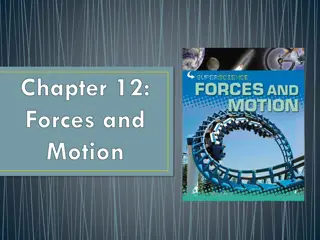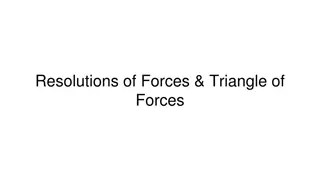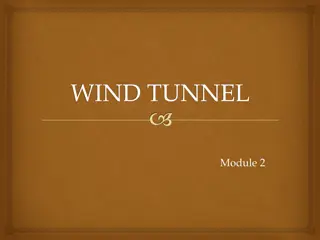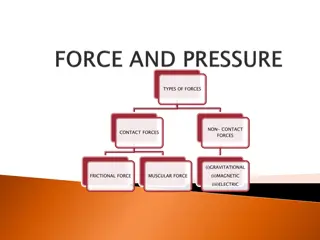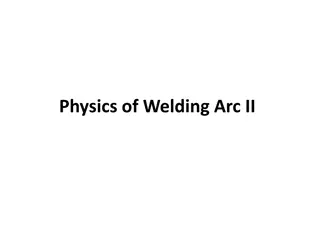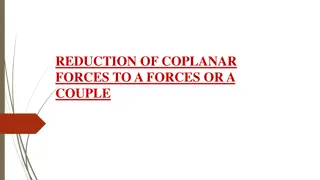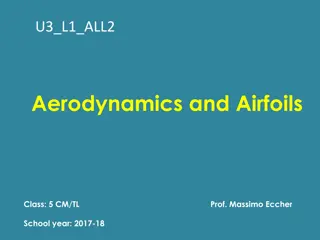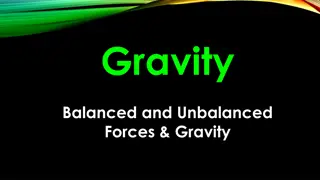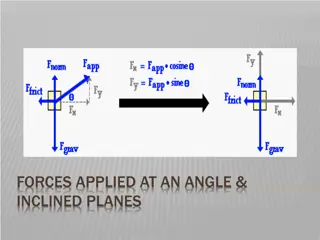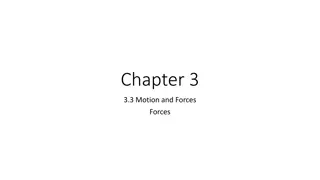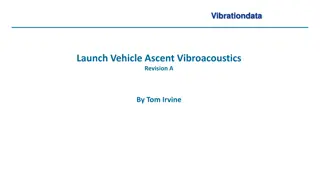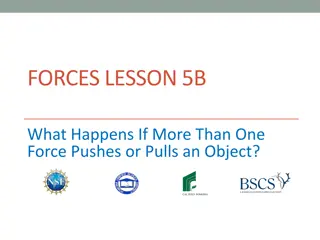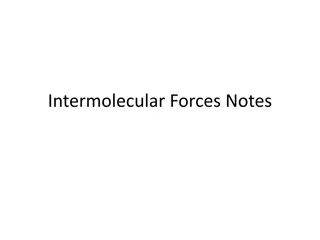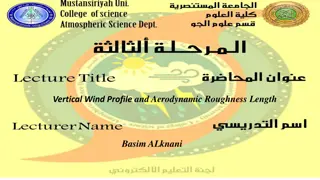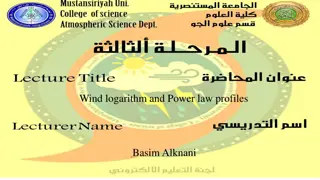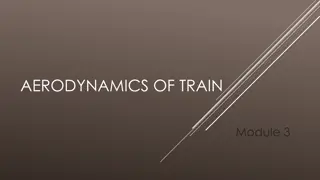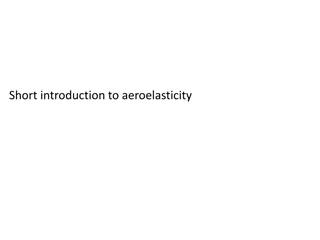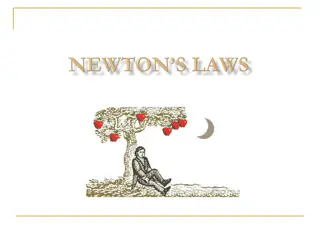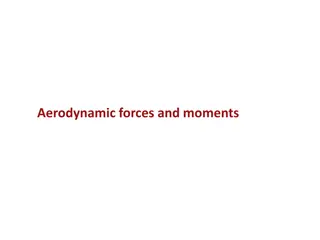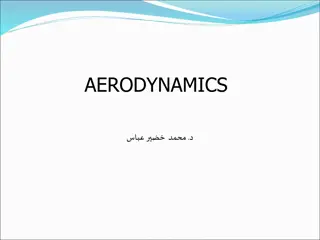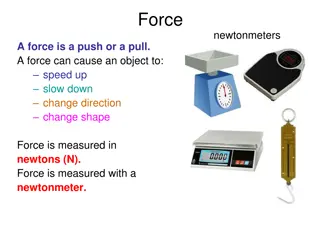Understanding Forces and Motion in Physics
Exploring the concepts of forces and motion, this content delves into the fundamental aspects of how forces impact objects' movement. Covering topics such as measuring force, representing force as a vector, combining forces through addition and subtraction, and understanding balanced and unbalanced
2 views • 61 slides
Understanding the Horse-Cart System: Forces and Acceleration Explained
The Horse-Cart problem delves into the dynamics of forces acting on a horse pulling a cart, highlighting the importance of net forces, accelerations, and external interactions with the ground. The analysis simplifies the complex system by focusing on key forces impacting the cart's movement and the
0 views • 17 slides
Understanding Boundary Layers in Fluid Dynamics
A boundary layer forms when a fluid flows over a solid surface, with viscous forces present close to the surface. It can be laminar or turbulent, determined by the Reynolds number. Flow separation occurs in adverse pressure gradients, affecting lift and causing drag. Efforts to delay separation incl
1 views • 19 slides
Understanding Resolutions and Triangle of Forces in Physics
Resolutions of forces involve breaking down a force into components, while the Triangle of Forces explores how forces interact in equilibrium. By analyzing graphical and mathematical representations, you can determine the resultant force and its direction using trigonometric functions. Applying the
1 views • 11 slides
Understanding Action and Reaction Forces in Physics
Explore the concept of action and reaction forces in physics through examples like a falling boulder and interactions between different masses. Understand how forces are equal and opposite, leading to accelerations based on mass and force interactions. Discover the relationship between Earth and the
0 views • 16 slides
Understanding Wind Tunnels: Devices for Aerodynamic Testing
Wind tunnels are devices that simulate air flows to test models under controlled conditions. They are classified as low-speed and high-speed tunnels, used to replicate flying or moving objects. Testing involves studying air motion using techniques like smoke visualization, colored threads, and speci
2 views • 37 slides
Understanding Different Types of Forces and Their Applications
This content explores various types of forces including non-contact and contact forces such as gravitational, magnetic, electric, frictional, and muscular forces. It also discusses the effects of forces on different surfaces and provides examples of force application in real-life scenarios.
1 views • 10 slides
Understanding Arc Forces in Welding: Gravity and Surface Tension Forces
Explore the significance of arc forces in welding, focusing on gravity and surface tension forces. Learn how these forces impact metal transfer, deposition efficiency, and welding quality. Discover the role of gravitational force in detachment and transfer of molten metal, and how surface tension fo
2 views • 25 slides
Understanding Coplanar Forces and their Classification
Coplanar forces are forces that lie in the same plane and can be classified into concurrent, parallel, non-concurrent, and non-parallel systems. These forces can be reduced to a single force or a couple for analysis. Understanding these force systems is essential in engineering and physics to determ
2 views • 20 slides
Understanding Central and Non-Central Forces in Physics
Newton's laws of motion introduced the concept of forces, leading to the classification of fundamental forces like gravitational, electromagnetic, strong nuclear, and weak nuclear forces. Central forces act toward or away from a fixed center, while non-central forces are affected by additional param
0 views • 7 slides
Understanding Van der Waals Forces and Intermolecular Interactions
Van der Waals forces encompass London dispersion forces, dipole-dipole forces, and hydrogen bonding, influencing interactions between atoms and molecules. London dispersion forces are the weakest and present in all molecules, dipole-dipole forces involve permanent dipoles, and hydrogen bonding, the
0 views • 9 slides
Understanding Forces in Physics
Explore the concept of forces in physics, including definitions, measurement units, combining forces, and their effects on objects' motion. Learn about balanced and unbalanced forces, net force, force pairs, directions, magnitude, and how to combine forces at right angles. Develop a solid understand
0 views • 24 slides
Understanding the Design of Airfoils and Wing Dihedral
The design of airfoils and wings involves key terminologies like mean chamber line, leading edge, trailing edge, chord line, and camber. Dihedral is an important aspect of wing design that affects stability and control. Aerodynamic forces on a wing, like lift and drag, are crucial for flight perform
4 views • 10 slides
Understanding Boundary Layer and Drag Forces in Fluid Dynamics
Boundary layer module explains the presence of viscous forces near a surface due to fluid flow, leading to laminar or turbulent boundary layers. Flow separation occurs when a boundary layer detaches from a surface, impacting lift and drag forces. Adverse pressure gradients and flow separation phenom
0 views • 19 slides
Understanding Gravity and Balanced/Unbalanced Forces in Physics
Explore the fundamental concepts of gravity and balanced/unbalanced forces in physics. Gravity is the force that pulls objects toward each other, acting universally. Balanced forces maintain object stability, while unbalanced forces can cause motion changes based on direction, strength, and mass. Di
0 views • 9 slides
Understanding Forces in Mechanics: Fundamentals and Applications
Prof. Madhuri Reddy, an Assistant Professor at Hope Foundation's International Institute of Information Technology, explains the characteristics of forces, systems of forces, and the concept of resultant force and composition of forces in mechanics. Forces are defined as agents that produce or destr
0 views • 11 slides
Understanding Lami's Theorem in Physics
Lami's Theorem is an equation that explains how the magnitudes of forces acting on a point keep an object in equilibrium. This theorem relates the forces with corresponding angles and is derived by understanding the sum of forces acting on a point. By utilizing complementary angles and the sine rule
0 views • 8 slides
Understanding Forces Applied at an Angle on Inclined Planes
Exploring the concept of forces applied at angles other than 90 degrees on inclined planes, the process involves resolving forces into component vectors, finding net forces in each direction, writing force equations (Fnet = ma), and solving for normal force and acceleration in practical scenarios li
0 views • 28 slides
Understanding Forces in Motion: A Comprehensive Overview
Forces play a crucial role in our daily activities, influencing motion and direction. This chapter delves into the concept of forces as pushes or pulls, exploring balanced and unbalanced forces and their impact on velocity. By examining real-life scenarios like kicking a soccer ball or opening a doo
0 views • 10 slides
Understanding Balanced and Unbalanced Forces in Physics
Forces play a crucial role in determining an object's motion. Balanced forces have a net force of 0 N, resulting in no change in motion, while unbalanced forces lead to a change in motion. Inertia, the resistance to changes in motion, and the concept of combining forces are also important in underst
2 views • 30 slides
Understanding Forces and Mass
Forces, such as contact and non-contact forces, interact with objects to cause motion or deformation. Mass is the amount of matter in an object, measured in kilograms. Learn about applied force, normal force, frictional force, air resistance, spring force, tensile forces, compressive forces, and she
1 views • 29 slides
Aeroacoustic Analysis of Launch Vehicle Ascent Dynamics
Investigate the vibroacoustics of launch vehicle ascent, focusing on the formation of turbulent boundary layers, aerodynamic excitation sources, and dynamic pressure coefficients. Learn about the transition to turbulent flow, shockwave formation, and the analysis steps involved in determining vibrat
0 views • 30 slides
Understanding Force Diagrams and Balanced/Unbalanced Forces
Explore the concepts of force diagrams, balanced forces, and unbalanced forces through visual examples and explanations. Learn how balanced forces keep objects stationary or at a constant speed, while unbalanced forces cause movement and changes in direction. Practice calculating resultant forces an
1 views • 11 slides
Understanding Lift: The Aerodynamic Force in Airplanes
Lift is the aerodynamic force that opposes the weight of an airplane, keeping it airborne. It is generated by the motion of the aircraft through the air, with the wings playing a crucial role in lift production. The amount of lift depends on various factors like the shape, size, and velocity of the
0 views • 35 slides
Understanding Forces: Effects of Multiple Forces on Objects
Exploring the impact of multiple forces on objects through scenarios involving friction, pushing, and pulling. Students investigate the role of gravity and analyze how different forces influence the movement or stability of objects. The lesson includes hands-on activities and discussions to deepen u
0 views • 10 slides
Understanding Intermolecular Forces: Strength, Types, and Examples
Intermolecular forces are attractions between molecules, weaker than chemical bonds. They include London dispersion forces, dipole-dipole interactions, and hydrogen bonding. Strength varies, with covalent bonds being the strongest and London dispersion forces the weakest. Different types of intermol
0 views • 15 slides
Understanding Intermolecular Forces and Dispersion Forces in Molecules
Particle diagrams of liquids, solids, and gases reflect distinct arrangements due to intermolecular forces. The existence of substances as gases, liquids, or solids at room temperature is attributed to the forces between molecules known as intermolecular forces (IMF), with dispersion forces being th
0 views • 30 slides
Understanding Vertical Wind Profiles and Aerodynamic Roughness Length
The interaction between wind and the Earth's surface affects wind profiles and aerodynamic roughness length. The nature of airflow over surfaces, changes in wind speed with height, and the concept of aerodynamic roughness length are explained. Techniques for estimating aerodynamic roughness length b
0 views • 8 slides
Understanding Wind Profiles and Aerodynamic Roughness Length
Wind profiles are crucial in understanding how wind speed changes with height in the boundary layer. The logarithmic and power law profiles depict this relationship, influenced by surface characteristics and obstacles. The aerodynamic roughness length, defining where wind speed becomes zero, remains
0 views • 14 slides
Understanding the Aerodynamics of Train Systems
The aerodynamic characteristics of high-speed railway trains are unique due to their long length, interaction with surrounding structures, and influence of cross-winds. Aerodynamic drag significantly impacts energy consumption, with the drag being proportional to the square of speed. Precise evaluat
0 views • 11 slides
Understanding Newton's Laws of Motion: Inertia, Forces, and Acceleration
Delve into the fundamentals of Newton's first and second laws of motion, exploring concepts such as inertia, the relationship between forces and acceleration, and the procedure for solving force problems. Discover how objects behave when left to themselves, and grasp the significance of forces in ch
0 views • 21 slides
Understanding Aeroelasticity: Deformation and Aerodynamic Forces
Aeroelasticity explores the intricate relationship between the deformation of elastic structures in an airstream and the resulting aerodynamic forces. This field of study is vital for predicting and managing interactions between structural mechanics and aerodynamics in aircraft design. Historical in
0 views • 15 slides
Understanding Forces and Equilibrium in Physics
Forces in physics can be categorized into contact forces and field forces, measured in units like Newtons (N). Inertia, mass, weight, and equilibrium are fundamental concepts in understanding the behavior of objects under different conditions. An object in motion stays in motion unless acted upon by
0 views • 15 slides
Aerodynamic Simulation of MARINTEK Braceless Semisubmersible: Insights and Tools
Explore the aerodynamic simulation of the MARINTEK Braceless Semisubmersible through advanced techniques and tools. Discover the unique aerodynamic actuator, simulation models, and tools used in the research conducted by Gordon Stewart, a post-doctoral researcher at NTNU. Gain insights into the expe
0 views • 16 slides
Understanding Aerodynamic Forces and Moments in Fluid Dynamics
Introduction to aerodynamic forces and moments in the study of fluid dynamics, particularly focusing on air as the primary medium of interest. The discussion covers thermodynamic properties, continuum hypothesis, and fundamental principles of classical mechanics applied to the analysis of aerodynami
0 views • 35 slides
Understanding Aerodynamics: Fundamentals and Applications
Aerodynamics is the study of airflow around objects and its impact on forces and moments. This field covers fundamental principles, aerodynamic variables, forces and moments, practical objectives, and more. By exploring topics like flow similarity and dimensional analysis, aerodynamic engineers pred
0 views • 17 slides
AVATAR Project: Advancements in Aerodynamic Tools for Large Rotors
The AVATAR project, funded by the European Union's Seventh Programme, focuses on advancing aerodynamic tools for large wind turbines, specifically in the 10-20MW range. Led by a consortium of top research institutions and industry partners, AVATAR aims to elevate aerodynamic and fluid-structure mode
0 views • 16 slides
AVATAR Project - Advanced Aerodynamic Tools for Large Rotors
The AVATAR project, funded by the European Union, aimed to enhance aerodynamic models for 10-20MW wind turbines, focusing on offshore applications to reduce Levelized Cost of Energy (LCOE). Led by EERA, the consortium included top research institutions and industry partners. The project ran from Nov
0 views • 6 slides
Numerical Analysis of Aerodynamic Performances in Biplane Configuration
This paper presents a numerical investigation comparing single versus double wing (biplane) configurations for aerodynamic performances. Geometric models and numerical analyses were conducted, providing insights into the advantages and complexities of biplane wings. The study utilized computational
0 views • 12 slides
Understanding Forces and Their Applications
Forces are pushes or pulls that can cause objects to speed up, slow down, change direction, or shape. They are measured in newtons (N) using a newtonmeter. Various types of forces include contact, tension, electrostatic, friction, and gravitational forces. Forces always occur in pairs, with equal an
0 views • 46 slides
